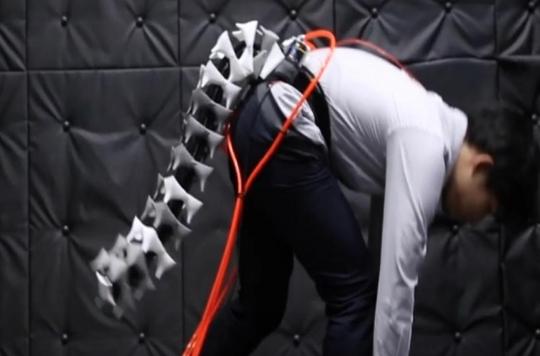Japanese researchers have developed a prototype biometric robotic tail that could help people with balance problems or those who regularly carry heavy loads.

“In some situations, our body may lack the ability to carry or balance us, such as when climbing a cliff or carrying heavy objects.” That’s why researchers at Keio University in Japan have developed a prototype biometric robotic tail. Named Arque, it could very soon be used by humans, they announced during the Siggraph Conference 2019 on the infographic held from July 28 to 1er August in Los Angeles, USA.
Arque is made of removable plastic vertebrae, the researchers explain in a video. Small weights can be inserted in each of them in order to compensate according to the size of the user. The device, made up of four artificial muscles, contracts under the impulse of an air compressor, which means that one cannot use it for long distances for the moment. Also, the researchers hope to be able to design a mobile and improved version quickly.
To create this tail, the scientists were inspired by that of the hippocampus. Extremely strong, it can withstand bites from larger predators, and is also very maneuverable since it allows it to cling to its environment, especially corals.
“Improve the natural functions of the body”
Ultimately, the researchers are counting on their invention to help people carrying heavy loads on a daily basis or patients suffering from a lack of balance, in particular because of their inner ear. But, this device could also be used in the field of entertainment. Its creators are thus considering a virtual reality application to allow players to find a better balance according to the environment they are exploring.
“With this work, we want to extend our bodily functions passively through this biometric tail,” argue the researchers in their video. And to conclude: “Arque is a new portable device that considerably improves the natural functions of our body”.
The expansion of robotics in healthcare
While artificial intelligence increasingly invades the field of health, many such tools are beginning to be used to facilitate the treatment or daily life of patients. In October, roboticists from the Municipal University of Hong Kong caused a stir when they announced that they had developed a mechanical centipede capable of delivering medicine at a specific location on the body without damaging the surrounding tissues in the process.
However, it still remains to test this machine in a living organism and to succeed, within a few years, in making it biodegradable so that it disintegrates without leaving toxic traces in biological tissues once its mission has been accomplished.
See below the explanatory video of the Japanese researchers:

















